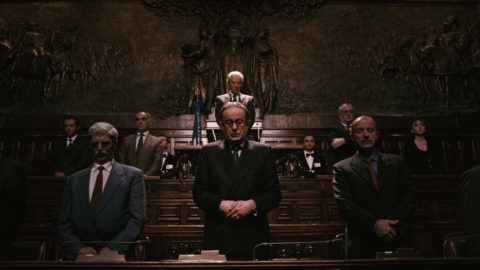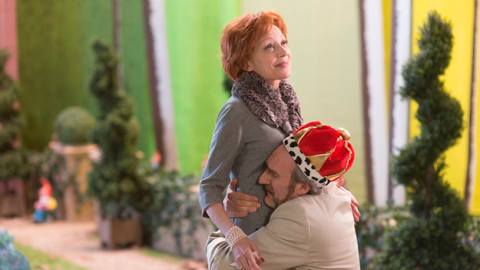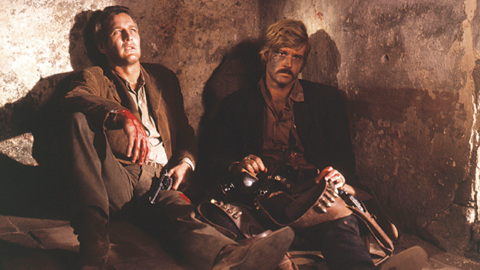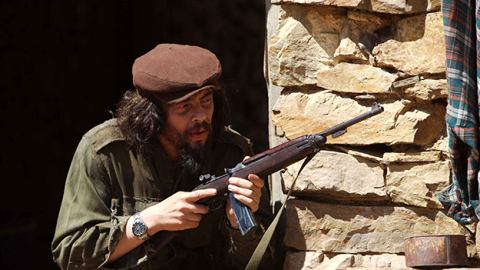
Frontier of Dawn
“Idiotic . . . naïve . . . looks like a perfume commercial.” These were among the comments I heard about Philippe Garrel’s Frontier of Dawn, whose press screening offered a muted variation of the now-legendary Brown Bunny incident of 2003. This didn’t surprise me. Frontier of Dawn was as out of place in Cannes as a factory-sealed Polaroid Swinger on display in a Mac store.
Of the above charges, the one that sticks is “naïve.” Garrel has always been a naïve artist, but is this a defect? Film culture breeds sophistication. What’s the latest? Who’s advanced the furthest? And who needs another black-and-white Garrel movie about his relationship with Nico? That Frontier of Dawn is Garrel’s first film after Regular Lovers, which is, among other things, a Garrel film for people who don’t know or don’t like other Garrel films, only made matters worse.
The director’s son Louis (“He can’t act . . . all he knows how to do is pout”) plays a photographer named François who has been hired to photograph a young actress named Carole (Laura Smet). They fall in love, he balks at her emotional volatility and finds a convenient excuse to ditch her. She is committed to a mental institution, and not much later she does herself in. One year later, François embarks on a new relationship with Eve (Clémentine Poidatz), less unhinged and far wealthier. The promise of stability is undone by a dark apparition: the face of Carole in the mirror, calling François to join her in oblivion. At this point in the screening, everything was funny.
Nicole Brenez once wrote that while she had little use for Garrel’s color films, she found that in his black-and-white work the patient, level gaze of the camera on intimate human affairs rendered the action “instantly allegorical.” Perhaps “elemental” is a better word. Garrel has always given us cinematic life lessons based on his own experience, made with a simplicity unavailable to most filmmakers—this is his “naïveté.” François’s friend evokes the potential “terror” of bourgeois happiness in one of Garrel’s typically pointed dialogue exchanges, and it’s a laugh riot in the press screening. Why? Because such questions are old hat and better left to 40th-anniversary celebrations of May ’68? Because Garrel lacks the sophistication to couch them within a more “believable” framework? This “stupid” movie, which made almost everything around it look either overwrought or calculating, prompts a question. If we can tolerate naïveté in music, dance, poetry, and opera, why do we scoff at it on a movie screen?

I Want to See
It’s a matter of context. Garrel is damned for naïveté, but not Straub and Huillet, touchingly represented in the Quinzaine (whose commemorative year was dedicated to Huillet) by the pairing of their last film together with his first one alone. There’s certainly not much in the way of sophistication in their later films, just the usual refinement of image and sound. So would Garrel have fared better if he had also been in the Quinzaine? Doubtless. As would Joana Hadjithomas and Khalil Joreige’s I Want to See (shown in Un Certain Regard), a flawed but moving study of Catherine Deneuve, as herself, reacting to the devastated Lebanese landscape. By the same token, Le Genou d’Artemide, Straub’s lovely farewell to his wife, would surely have been laughed off the screen in the competition. A great deal of critical attention is devoted to the question of where a film is placed in Cannes. Because after all, shouldn’t every film know its place?

Blindness
It was quickly decided that the opening-night selection, Fernando Meirelles’s adaptation of Blindness, would have been out of place pretty much anywhere. Rightly so. Is Blindness naïve or sophisticated? It depends on how you look at it. The constant whitening of the screen, which I was assured was a literal translation of novelist José Saramago’s prose, was so aesthetically amorphous that it quickly became monotonous, as did the bizarrely unmoored camera eye—did Meirelles ask the DP to pretend that he was blind? I suppose that there’s a great deal of sophistication behind this misbegotten movie, albeit at a level of misalliance with the material that reaches comic proportions. On the other hand, Meirelles seems to have labored under the naïve misapprehension that his English-speaking North American cast, adrift in a culturally undefined totalitarian state, adequately represented the human condition. We are all Canadian.

Liverpool
Like every Lisandro Alonso film, Liverpool seems at once willfully naïve and extremely sophisticated. Alonso is a fascinating figure, who probably thinks more about form than any other narrative filmmaker his age. His attempts at overall unity are impressive if not fearsome, even when he miscalculates. At his finest, Alonso settles on journeys that accumulate observation (of landscapes and ways of life) that expand along the way into collectively internalized visions of existence and their horizon lines. In Liverpool, a man who’s been away at sea for years returns to his parents’ home in Tierra del Fuego to see the daughter he left behind, and then picks up and leaves again. What is expected, for those who know Alonso’s films, is the lonely majesty of the setting: logging country, an existence out of Ethan Frome, the feeling of marginal people on the edge of the world. What is unexpected is the unforced grandeur of the narrative/formal/thematic arc: out at sea one longs for land, and stuck on land one dreams of sailing over the horizon. It’s easy to imagine Alonso running aground someday with his severely restricted aesthetic approach, and his new film does provoke some interesting questions: has he cultivated his travels through everyday life in far-flung places as a way of avoiding risk or courting it? Is he as wary of human contact as his solitary characters? Questions aside, this was one of the best movies in Cannes.

Three Monkeys
And it was a welcome antidote to Nuri Bilge Ceylan’s Three Monkeys, another film that would be just as much at home in a gallery as in a cinema. Ceylan is a perfect example of a filmmaker whose sophistication is so confined to the limits of his own moment as to amount to a kind of naïveté: all that is memorable in his cinema is the insistence and extremity of his fashionable choices. There was much talk of this failed melodrama as a comedown from his previous work, but it seemed to me neither better nor worse than Climates or Distant. Ceylan is an all-strategy filmmaker who parachutes his almost-characters—brooding men and faithless, flighty women—into lengthy durations of little distinction: his temporal stretches are as meaningless as his digitally denatured skies and trees. Is it possible to detect “the influence of Antonioni” in Three Monkeys? I’ll say. It’s difficult to imagine this terminally noncommittal artist milling anywhere but in Antonioni’s shadow.

Changeling
Where Ceylan dipped one toe into Cain/Woolrich territory, Clint Eastwood dove into the deep end of the melodramatic pool. Unlike Three Monkeys, his beautifully appointed period tale Changeling, based on the Wineville Chicken Coop Murders of the late Twenties, is a much richer and more complex film than it appears at first glance. Intended, like Flags of Our Fathers, to correct an officially burnished American past, Changeling begins as a story of institutionalized authoritarianism. A boy is kidnapped in broad daylight. After a perfunctory search, a different boy is presented to his distraught mother (Angelina Jolie). When she raises a ruckus, she’s thrown into a psych ward by the irredeemably corrupt LAPD. That Eastwood made such a relatively subtle film out of such a harrowing story is partly attributable to his casting. As the cop with the unfortunate duty of silencing the mother, Jeffrey Donovan shades ambivalence and repressed empathy into the margins of his role. John “Reptilicus” Malkovich as the crusading minister who springs the mother from jail disturbs the waters even further. At about the halfway mark, Eastwood shifts gears and revisits the spiritual terrain of Unforgiven and Mystic River, where the consummation of vengeance leads to emptiness. The result is a dramatically bifurcated film, in which the shift in power from the cops to the mother doesn’t gather quite enough force. Eastwood does a good job of tamping down his superstar actress, although I wish that Jolie had endowed her working mother with a little more internal drama. But a Clint Eastwood movie with a few bumps in the road is infinitely preferable to a smooth ride like Laurent Cantet’s Palme d’Or winner The Class.

Gomorrah
Cantet’s classroom movie prompted unfavorable comparisons from more than one critic with season four of The Wire, as did Matteo Garrone’s adaptation of Roberto Saviano’s Gomorrah. Garrone’s task is to stay true to the rough immediacy of his muckraking source and render it dramatically viable at the same time. His predictable solution is to crosscut between an assortment of individuals caught in the gears of the Neapolitan underworld, and his movie continually drops and picks up its characters in a dutiful yet uninspired manner. Garrone also cultivates an affectedly rough visual style, about one degree removed from standard documentary stalker-cam. The secret power behind this movie, I think, is its excellent ensemble acting—finally, Italian actors have something real to chew on. Gomorrah is far from perfect, but passages in Moretti’s The Caiman aside, it’s the first Italian film I’ve seen in years that makes sense in relation to the dire state of the nation itself. Just as the first half of Changeling offers an apt model of life in Bush’s America, Gomorrah is just the movie for a country that has installed a true despot in office not once, not twice, but three times.

The Headless Woman
Sophistication and naïveté, confidence and riskiness, the icily clinical and the warmly affectionate converged in the two greatest films I saw in the official selection at Cannes, Lucrecia Martel’s The Headless Woman and Arnaud Desplechin’s A Christmas Tale. Despite the fact that both films are set within family milieux, they couldn’t be more different. Where Martel’s close study of a woman suffering from the aftereffects of an auto accident (in which she may or may not have killed a child) is a feat of restriction and confinement, Desplechin’s Shakespearean banquet is a feat of emotional, verbal, visual, and aural cacophony. Where Martel excitingly confines herself to her heroine’s traumatically realigned viewpoint (the scope frame is used in the most exacting fashion, in conjunction with the soundtrack, to suggest a hallucinatory mental space both within and without María Onetto’s character), Desplechin sprawls just as excitingly from situation to situation, character to character, emotion to emotion (the scope frame is a warm enclosure bustling with activity). Where information is imparted obliquely in the Martel (I’ve seen the film twice and there are still plot points that elude me), the particulars of Desplechin’s film are boldly declaimed in a series of joyous arias and duets. Martel, as Resnais did with Delphine Seyrig in Muriel, rests a great deal on the strong shoulders of Onetto, while Desplechin builds from the crisscrossing energies of a brilliant ensemble.

A Christmas Tale
There are also interesting points where the two films meet. Both directors are unashamedly if not passionately invested in the clinical, albeit from two different perspectives: by her own admission, Martel has a forensic sensibility, and in her hands the camera and the microphone are probing and sometimes healing instruments; while Desplechin, as always, happily incorporates genuine physical and mental ailments into his human comedy (a lovingly handled bag of bone marrow fluid makes for one of the film’s finest images). More importantly, Martel and Desplechin both dive fearlessly into the maelstrom of the family. When Hippolyte Girardot’s son-in-law walks out of the house to avoid all the “dysfunctional” bickering and blind furies unleashed within, he’s the one who looks like a fool: he’s temporarily mistaken himself for a character in The Family Stone. For Martel and for Desplechin, the family laboratory, maddening as it may be, is where all life begins and ends.








